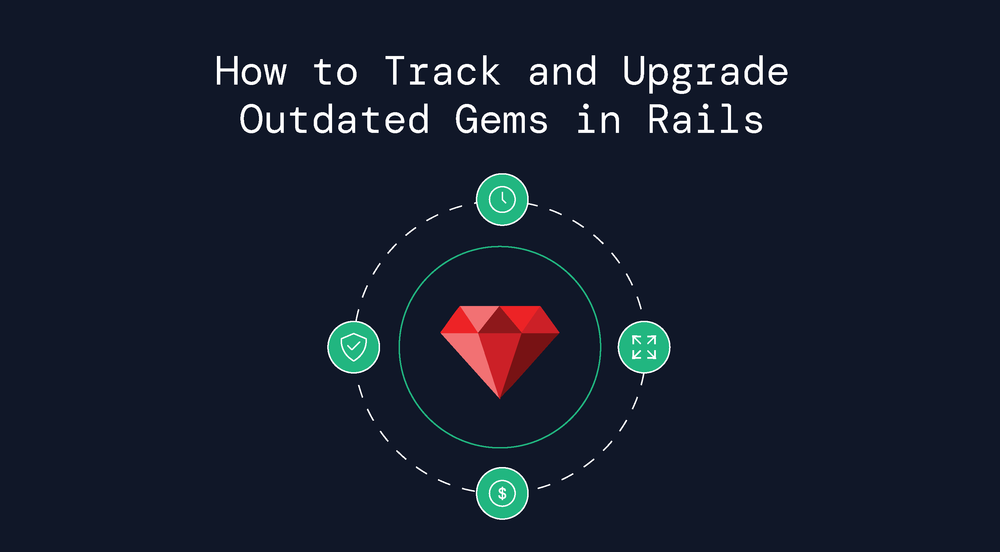If you're working with a Ruby on Rails application, you already know how much power and flexibility Ruby Gems brings to your project. They're the building blocks behind everything from authentication to background processing. But like all good things in tech, they don’t age well if left unattended.
Let’s talk about how to monitor and update your out-of-date gems and why it’s so important, not just for performance, but for security, stability, and scalability too.
Understanding Ruby Gems
Ruby gems are packages of code that extend or modify functionality in Ruby applications. They are pre-built blocks of functionality that you can plug into your application without reinventing the wheel.
The Rails framework itself is actually a gem - probably the most famous one in the Ruby world. But there are thousands of others: from authentication solutions like Devise, to admin panels like ActiveAdmin, to background job processors like Sidekiq.
These gems are open source, which means they’re constantly evolving. Developers all over the world contribute to them, fixing bugs, closing security loopholes, and optimizing performance. They save tremendous amounts of time, but updating the gems and playing nicely together? That's where things get interesting.
Is it safe to use Ruby Gems?
The short answer is: yes, most popular Ruby gems are safe to use, but you need to exercise due diligence. The Ruby community is generally excellent about security, and RubyGems.org (the main repository) has security measures in place.
But just like with any open-source software, vulnerabilities can sneak in. The problem doesn’t usually lie in using gems, it’s in using outdated ones.
Outdated gems can have unpatched security flaws, deprecated code, or incompatibilities with the latest version of Ruby on Rails. That's why regularly monitoring and performing a ruby gem upgrade is not just a good habit, it’s essential.
That said, here are some practical tips to follow:
- Stick to well-maintained gems with active communities and recent updates
- Check the number of downloads and GitHub stars as rough indicators of reliability
- Look for gems that explicitly mention security practices
- Run bundle audit check --update regularly to check for known vulnerabilities
Why Should I Keep My Gems Updated to the Latest Version?
Three words: Security. Performance. Compatibility.
When you keep your gems updated, you're not just getting access to new features. You're ensuring your app stays secure, efficient, and compatible.
- Security: Many gem updates are prompted by vulnerabilities. An out-of-date gem might expose your app to serious threats.
- Performance: New versions often come with performance boosts.
- Compatibility: As you plan your ruby on rails migration to a newer version, you’ll want your gems to support it.
So before you ask how to update ruby or upgrade gem version, ask yourself if you’re willing to take the risk of not updating at all.
How to Check Gems Ready to Update in Your Rails App?
Most Rails developers start with a Gemfile and probably don’t look at it again until something breaks. But you don’t want to wait for that moment.
Keeping an eye on your gem dependencies means:
- Knowing which gems are outdated
- Knowing which ones are deprecated or no longer maintained
- Understanding the impact of a ruby gem upgrade before you run bundle update
Here's how to update gems while keeping tabs on what's running in your application:
First, get a clear picture of your current gem environment:
bundle outdated
This command shows which of your gems have newer versions available. I run this at the beginning of each sprint to stay ahead of needed updates.
For a more detailed analysis:
gem list
This lists all installed gems and their versions.
To check ruby version in your current environment:
ruby -v
Remember that your application's Gemfile specifies which gems and versions your application depends on, while Gemfile.lock records the exact versions that were installed.
Essential Tools to Track and Update Gems
Manual checking and updating works fine for small projects, but as your application grows how do you update your gems? You'll want more automated solutions. Here are some tools that are invaluable:
- Bundler-audit: Checks for known security vulnerabilities in your gems.
- Dependabot: Automatically opens pull requests to update your dependencies when new versions are released.
- RailsUp: This is my go-to tool these days for checking ruby gems compatibility. It does more than just tell you what needs updating – it helps you understand the impact of each update and manage the ruby gem upgrade process intelligently.
What makes RailsUp particularly useful is how it handles the often-tricky ruby on rails migration paths when gem updates are involved. It analyzes dependency graphs and suggests update paths that minimize disruption.
Teams can reduce their upgrade time by 40% using RailsUp's systematic approach to checking gems compatibility. The tool's ability to check ruby gems compatibility before applying changes saves one from more than a few late-night debugging sessions.
Navigating the Web of Gem Interdependencies
Here’s the tricky part about gem updates: it’s not always one-to-one. One gem might depend on another gem, which depends on another gem… and so on.
Upgrading one gem might break another if you don’t consider interdependencies. And when you’re juggling 30+ gems, this becomes a web of potential chaos.
RailsUp helps here too. It gives you a clear picture of which gems are safe to upgrade and which ones might cause conflicts. This makes it a lot easier to answer those haunting questions: Should I upgrade now? Will it break something? Do I need to wait for another gem to update first?
Making Gem Monitoring a Team Responsibility
Too often, gem monitoring falls into the "we’ll do it later" bucket or is left to a single developer. But updating gems isn’t a one-time chore. It’s an ongoing process that should be baked into your development workflow.
- Set reminders to run checks monthly
- Make it part of your CI pipeline
- Educate your team about the risks of outdated dependencies
Using a tool like RailsUp can make this a shared, low-effort task rather than a massive quarterly overhaul. Everyone can access the compatibility reports and make informed decisions.
Practical Steps for Upgrading Gems
When it's time to actually perform updates, here's our approach:
- Never update everything at once. Batch your updates logically
- Start with security updates. These can't wait
- Update one major component at a time. If you're doing a rails gem upgrade, do that separate from other major changes
- Run your test suite after each significant update. Catch problems early
- Use RailsUp to analyze compatibility before committing to updates
- For larger projects, consider maintaining a staging environment that's a few weeks ahead of production in terms of gem versions. This gives you time to catch subtle issues before they hit production
Final Thoughts
If you’re serious about maintaining a healthy, secure, and scalable Rails app, gem management isn’t optional. It’s critical.
And if you’re looking for a smarter way to handle it, give RailsUp a try. It’s built to help you check ruby gems compatibility, plan upgrades confidently, and reduce the friction of maintaining modern Rails applications.
Don't have the time or resources to manage your gem updates in-house? RailsFactory offers comprehensive Rails upgrade services to handle everything from routine gem maintenance to full-scale version migrations. Our team of Rails experts can help you navigate the complex world of gem dependencies, ensure compatibility, and keep your application secure and performant.
Contact RailsFactory today for a free consultation on how our Rails upgrade services can help your team focus on building features rather than wrestling with dependencies.


